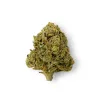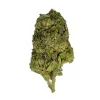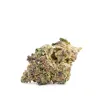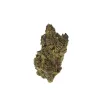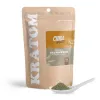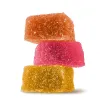Whether you shop for hemp-derived cannabinoids online or browse the shelves of marijuana dispensaries in person, you’ve probably already noticed that every cannabis strain is grouped into three main groups: indica, sativa, and hybrid.
If you’re new to cannabis, you probably didn’t know there was so much to getting stoned.
But if you started smoking weed at a younger age, you’ve likely already gotten the stoner rundown from a dealer or older sibling that was high out of their mind and trying to explain why Northern Lights is so different from Sour Diesel. In reality, both buds looked the exact same to you—and let’s face it, you weren’t looking for a science lesson, you only wanted to get high.
Either way, it’s not too late to learn about the in-depth similarities and differences between indica, sativa, and hybrid strains! Let’s jump right into where these strain types come from, how to choose the right group for you, and what other methods there are to determine a strain’s properties and effects.
Sativa vs Indica Chart
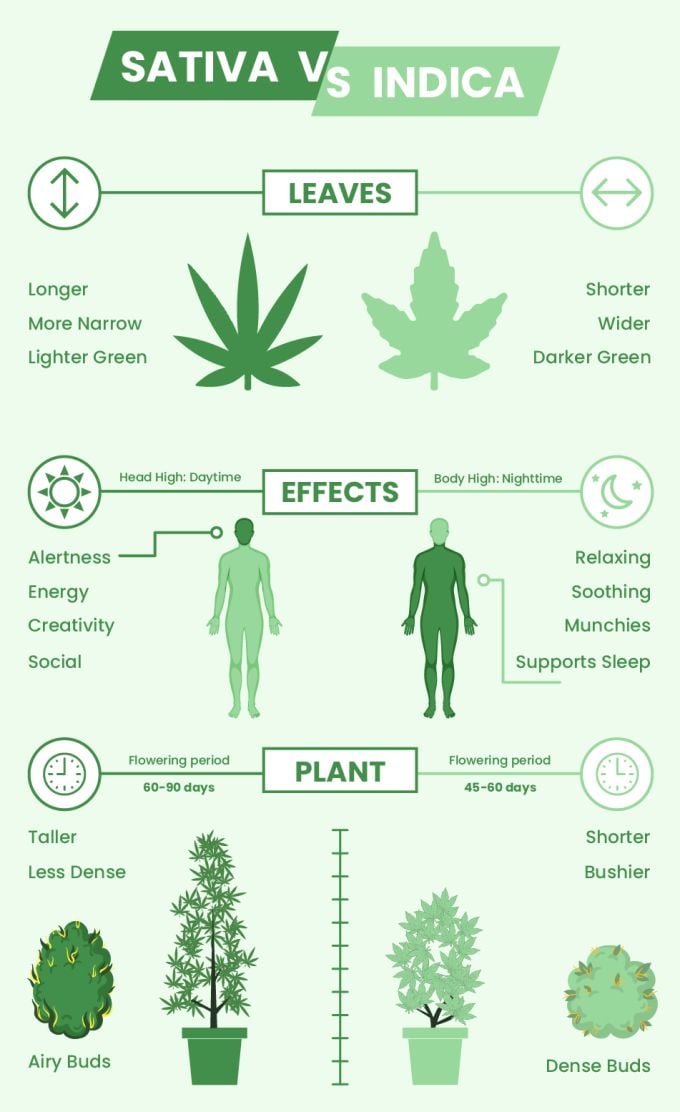
Sativa Explained In-Depth
Cannabis sativa plants are native to East Asia, but they can also be grown in other primarily hot, dry climates, such as Africa, Central America, and portions of Western Asia. Today, sativa is grown all over the world. These plants are categorized as tall and thin with finger-like leaves. They often grow taller than 12 feet tall and take much longer to mature than other types of cannabis.
Sativa plants commonly offer lower doses of CBD and higher doses of THC, so strains of this type are best for those who crave a cerebral, brain-targeting high. Its effects are energizing, focusing, creative, and anxiety-reducing. These properties make sativa strains perfect for daytime use, as they boost productivity and energy levels. In other words, sativa strains are great for waking and baking when you’ve got a long day filled with tasks and projects ahead of you.
Some of the most popular sativa strains include Durban Poison, Sour Diesel, Strawberry Cough, Jack Herer, and Green Crack. When using these strains, you will feel creative enough to come up with plans, take on artistic endeavors, and complete menial and important tasks alike, and the best part is, the strain will also equip you with enough energy and focus to actually do something with all that creativity!
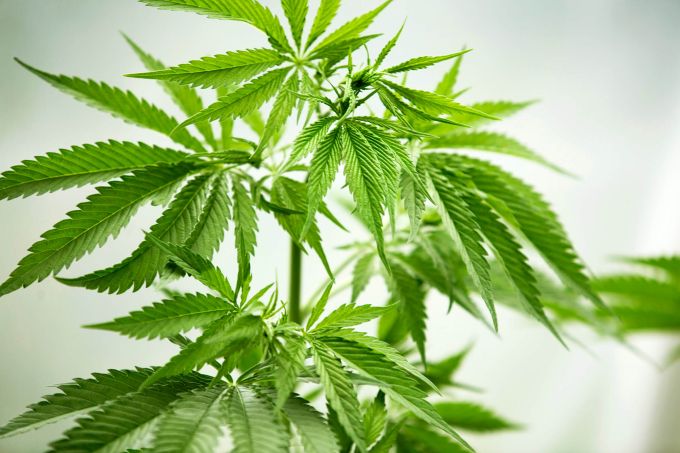
Indica Explained In-Depth
Cannabis indica is indigenous to Afghanistan, Pakistan, India, and Turkey, but like Cannabis sativa, it is grown all over the world today. These plants thrive in harsh, dry, and tumultuous climates, as they have adapted to the weather conditions of the Hindu Kush mountains from which they originate. Indica plants are commonly short and bushy, equipped with chunky leaves that grow wide and broad. Indica strains grow faster than sativa, and each plant produces more buds.
Indica also often contains higher levels of CBD than sativa strains, but that doesn’t necessarily mean they have lower THC contents. Because these strains contain higher amounts of CBD, they are often sought after for their relaxing, pain-relieving, and munchies-inducing effects. Since they’re often sedating, indica strains are best used at night as a way to unwind from a long day, have a good meal, and then fall into a deep and peaceful slumber.
Some popular Cannabis indica strains include Northern Lights, Wedding Cake, Girl Scout Cookies, and Granddaddy Purple. When using these strains, you will feel a full-body stone, leading you to enter a relaxed state perfect for chasing worries away and battling insomnia.
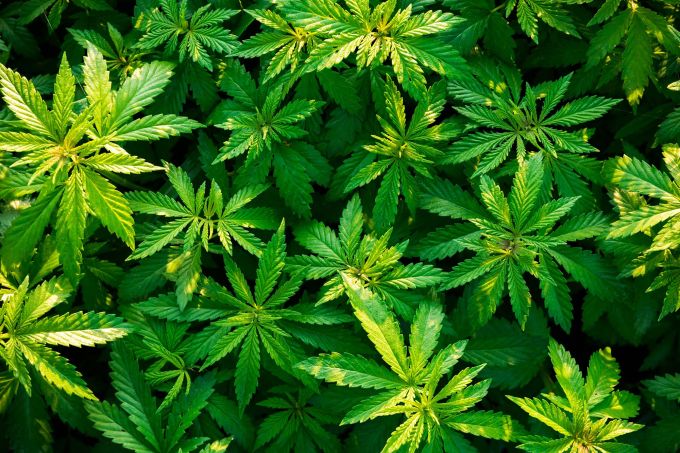
Hybrids Explained In-Depth
Hybrids, as their name may suggest, are strains created from a combination of indica and sativa strains. They are typically grown on farms or greenhouses from two or more cultivars. Generally, there are four types of hybrid strains:
|
Type of Hybrid Strain |
What Are They? |
|---|---|
|
Sativa x Sativa |
Two different sativa strains are bred together. |
|
Sativa x Indica |
A hybrid strain with sativa-dominant characteristics but equipped with the properties of both. |
|
Indica x Sativa |
A hybrid strain with indica-dominant characteristics but equipped with the properties of both. |
|
Indica x Indica |
Two different indica strains are bred together. |
Breeding new strains of cannabis involves the same basic process as it does with all plants. A female plant is pollinated with male pollen. This happens naturally, but in hybrid creation, growers use selective breeding in a controlled environment. In other words, they pick the female plant and male pollen for their specific sets of characteristics.
Seeds germinated in this process are considered first generation hybrids of both parents. Those who have the desired traits will be bred again. Once these traits have been produced, cultivators will breed a child hybrid with a parent strain to reinforce the characteristics. This process is usually repeated across three or more generations in order to stabilize these traits. While the wording here is icky—and this stuff certainly didn’t work for any European monarchy—breeding child strains with their parents is an effective way to reinforce their properties. Cannabis can also be propagated asexually, such as through cloning, cuttage, or root division. Asexual reproduction, however, can only produce the same plant over and over again.
The properties of hybrid strains are hard to pinpoint. They depend on the combination of the parent plants. Hybrids are popularly bred as a way to increase THC percentages, but each hybrid has a unique ratio of both CBD and THC. The effects caused by these strains can range from being more sativa-like or indica-like depending on which parent has dominant genes. You remember Mendel’s laws of inheritance from high school biology, right?
Some popular hybrid strains include OG Kush, Cherry Pie, Blue Dream, Gorilla Glue, and Pineapple Express. Because the properties of a hybrid aren’t set in stone, we recommend that you look out for information detailing which strain’s effects are more prevalent. If you want lots of energy but also a subtle and relaxing body high, go for sativa-dominant hybrids. If you’re looking for soothing pain relief that won't knock you out cold, opt for an indica-dominant strain.
Sativa vs. Indica Effects
As we’ve previously mentioned, indica and sativa have their own independent sets of effects. This creates distinct psychoactive experiences and physiological effects in consumers of each type of strain.
Sativa vs Indica
Sativa vs. Indica High
Sativa is known for its cerebral high. This is the strain type you go for if you want to giggle and goof off with friends. Sativa strains can also put you in a pensive state of mind, often allowing you to focus on feelings and thoughts that were once not so prevalent in your mind. They tend to be invigorating and energizing, helping you thrive in social and task-related scenarios by inducing a sense of comfort and focus. You’ll feel talkative, active, and ready to do anything with a happy-go-lucky attitude.
Indica, on the other hand, offers more of a body high. Not only will it make you feel sedated and deeply, deeply relaxed, but it will also give your body a sense of soothing numbness you’ll be thanking the weed gods for. Indica strains are perfect for chill nights in where you’re free to lounge on the couch like a potato for hours on end. Speaking of potatoes, be sure to keep the chips at arms’ reach—you’ll get some serious munchies, but getting off the couch even for a second will seem akin to running an Olympic marathon. With indica, you get the full spectrum of cannabis’s most relaxing, soothing, and sedating properties, but your stomach certainly won't get the memo!
Here's a chart to help you better visualize the effects of indica and sativa:
|
Indica |
Sativa |
|---|---|
|
|
Sativa vs. Indica for Pain
While both strains of cannabis can make for a good time and an incredible high, one of these two strains is preferred for pain relief. Indica has higher CBD contents than sativa, and strains of this type are effective at soothing pains and numbing the body. This sedating body high makes indica strains the perfect candidate for those seeking to treat pains.
A study published in 2014 to the Journal of Alternative and Complementary Medicine found that users prefer sativa strains to improve energy and mood, but they reach for indica strains when it comes to pain management, sedation, and sleep. Indica’s properties have been used by people looking for relief from chronic or acute pain, including pains from diseases like arthritis. Additionally, cannabinoids were found effective as a way to regulate nausea and vomiting in a 2011 study published in the National Library of Medicine.
So, while indica and sativa can both make for fun and pleasant highs, research suggests that indica strains are better equipped to help users treat pain.

Sativa vs. Indica Edibles
Our conventional cannabis knowledge already tells us that sativa will provide energizing and focusing effects, while indica strains are powerful relaxants that will leave you couch-locked for hours.
But there’s much more to strains than just their effects. How you consume cannabis will determine how exactly a strain affects you. Taking one or two puffs from a vape will give you a light psychoactive experience, with less pronounced effects than you would get from taking a couple hits from a joint or blunt. Dabbing, on the other hand, will deliver intense effects immediately, but this method isn't fit for beginners.
Edibles are generally the best way to consume weed if you want long-lasting and potent effects. But be careful, edibles can be tricky because they take longer to kick in than other methods. This might make it hard to dose edibles accurately—because edibles can take over an hour to set in, you may feel like you didn’t take enough gummies or chew on enough brownies. But before taking more edibles, be sure to wait around an hour or two for the first round to take effect.
When you take edibles, they must first bypass your digestive system in order to reach the bloodstream. Additionally, when THC is ingested orally, it is converted into 11-hydroxy-THC, a metabolite that is the reason taking edibles feels more potent than smoking weed, according to a 1973 study published in the National Library of Medicine.
Because edibles will make you feel the effects of your preferred strain more deeply and intensely, it’s crucial that you start low and slow and work your way up to the perfect dose. It may seem like a lot of trial and error, but a little patience is much preferred to hyperventilating on the couch or having a panic attack at work.
Ruderalis Explained
So, we’ve already discussed the differences between indica, sativa, and hybrid cannabis strains, but there is another, lesser-known cannabis classification of cannabis strains: Cannabis ruderalis. According to Jorge Cervantes, the author of The Cannabis Encyclopedia, “Botanists disagree as to whether c. ruderalis qualifies as a separate species of subspecies.”
The term ruderalis originates from ruderal, which in the plant world describes a plant that grows in spite of its environment being inhabited by humans or being otherwise disturbed by natural occurrences in the area. Cannabis ruderalis is native to Asia, Central and Eastern Europe, and more specifically, Russia. Many believe ruderalis to be a descendant of indica strains that adapted to harsh climates and shorter growing seasons in the northern region of its origins. Breeders use the term “ruderalis” to identify varieties of the hemp plant that had escaped human cultivation and adapted to the extreme environments found in these areas.
While it was originally considered a wild breed, Cannabis ruderalis has been brought indoors and used to make new hybrid varieties.
Cannabis ruderalis plants are said to:
-
Be 1 to 2.5 feet tall
-
Have thick and sturdy stems
-
Automatically flower after between 21 to 30 days of vegetation
-
Be ready for harvest at 70-110 days from seed
The effects of ruderalis are minimized due to its naturally low concentrations of THC. That said, its stability and short grow cycle make the plant attractive to breeders who want to benefit from its autoflowering trait. When crossed with other strain types, ruderalis gives breeders the ability to create a hybrid with the plant’s autoflowering properties and the advanced potency and flavor profile from its partner.
Strains made with this type of cannabis will often have the words “automatic” or “autoflowering” in their names. The strain isn't known for any particularly desirable flavors or aromas, but rather used as a way to strengthen new hybrids such as Northern Lights Automatic, Royal Gorilla Automatic, and Membrana Hiper Autoflowering.
Crossing ruderalis with other strains creates a hybrid with an automatic switch from vegetative growth to the flowering phase, which makes the process much quicker and efficient for growers and breeders. In essence, ruderalis is like the smartphone of weed.
Cannabis Strains to Consider for Certain Conditions & Effects
Because cannabis strains are all so different, they can each be considered to treat different conditions and effects:
|
Strain Name |
Strain Type |
CBD Content |
THC Content |
Helps With |
|---|---|---|---|---|
|
Acapulco Gold |
Sativa |
0.1% |
15-23% |
Stress, nausea, pain |
|
Blue Dream |
Hybrid |
<1% |
30% |
Pain, inflammation, insomnia, mental fog |
|
Granddaddy Purple |
Indica |
6% |
17-23% |
Lack of appetite, insomnia |
|
Maui Wowie |
Sativa |
0.55% |
13-19% |
Fatigue, depression |
|
Sherbet |
Hybrid |
<1% |
18% |
Happiness, creativity, relaxation |
|
Northern Lights |
Indica |
0.1% |
16% |
Pain, mood, insomnia, lack of appetite |
|
Green Crack |
Sativa |
<1% |
17% |
Energy, stress, euphoria |
|
Pineapple Express |
Hybrid |
<0.1% |
23% |
Mental fog, pain, socializing |
|
Purple Punch |
Indica |
<1% |
19% |
Relaxation, stress, energy |
How to Choose the Right Strain – Things to Consider
With all this newfound knowledge on indica, sativa, hybrids, and even the fabled ruderalis, you may feel absolutely equipped to choose the perfect strain for yourself. But the truth is, there is much more to strains than just what type of strain they are and what effects they provide. Each strain has its own individual cannabinoid content, and your body may react differently to two similar strains despite their proximity. When it comes to choosing strains, here are a few things to consider.
Tolerance
Your tolerance to THC will determine which strain is a best fit for you and your needs. You may be interested by the euphoric full-body effects of Godfather OG, but at a whopping 34% THC level, this strain may not be fitted for you if you’re a beginner, intermediate, or evens seasoned stoner. While some strains may seem to check all your boxes when it comes to effect and feel, you need to be sure to check their cannabinoid contents to make sure you can handle it well enough to actually have a good time. Some people are prone to THC-induced paranoia or anxiety, so biting off more than you can chew can put you on edge—or send you over the edge—instead of relaxing you.
While making sure you understand the effects and properties of each strain is important, choosing a strain with a realistic and manageable THC content is equally as crucial.
Dosage
On the same topic of tolerance, dosage is an important aspect of a fun and positive THC experience. While overdosing on THC is not fatal, it can certainly lead to uncomfortable and sometimes harmful effects, including:
-
Confusion
-
Cottonmouth
-
Dry eyes
-
Problems with concentration
-
Slowed reaction times
-
Fatigue
-
Headaches
-
Dizziness
-
Increased heart rate
-
Anxiety
-
Paranoia
-
Panic
Because we don’t want you lethargic on your couch or panicking in a public area, it’s best to dose cannabis by starting low and working your way up to an amount that works for you. As a rule of thumb, it’s always best to start low and build your way up to the perfect high, but here’s a little chart that might help you understand how to dose:
|
Dose |
Amount of THC |
|---|---|
|
Low Dose |
1-2.5mg |
|
Moderate Dose |
2.5-15mg |
|
High Dose |
30-50mg |
|
Very High Dose |
50-100mg |
Body Chemistry
Each body is different, not only in appearance, but also in chemistry. We all have different weights, metabolism rates, and tolerance. This means that while your friends may tap out after a few hits, you may still feel ready to keep on going (or vice versa). The point is, what works for you may not work for others and what works for others may not work for you.
Cannabis works by interacting with many of your bodily systems. Primarily, cannabinoids interact with the Endocannabinoid System, which is a unique communications system throughout the brain and body that affects how you feel, move, and react.
The endocannabinoid system contains endocannabinoids, receptors, and enzymes that are linked together and affect body processes. While the system was only discovered a few decades ago, what we know from the little research there is, is that it influences hunger and weight loss, learning and memory, and healing.
Your job as a responsible consumer is to make sure you understand how introducing external cannabinoids to your body will make it react, which brings us to our next point.
Desired Effect/Mood/Experience
The main and most attractive property of strains is that a quick Google search can tell you all you need to know about what kind of strains they are, what effects they will produce, and how much THC is in them. As we’ve mentioned over and over again, what kind of strain you choose depends on your desired effects, how you want to feel, and the experience you want to have when ingesting cannabis.
If you want a low-key, relaxing, and sedating experience, go for indica. For a more energizing and focusing effect, choose sativa. For a little bit of both, choose a hybrid that accentuates the effects you crave from both of them.

Understanding Cannabinoids & Terpenes in Cannabis
While type, body chemistry, and effects are all important when it comes to picking strains, that’s not all there is to it. If you look beneath the surface, you will find the cannabis plant is brimming with wondrous and interesting compounds, but two of the most important are cannabinoids and terpenes. So, what exactly are these?
What Are Cannabinoids?
Cannabis contains around 480 different compounds, but only around 100 of them are considered cannabinoids. They are defined as any of a group of closely related compounds that include the active constituents of cannabis. While CBD and THC are the plant’s most famous, it contains many other cannabinoids. They are separated into seven subclasses:
-
Cannabichromenes (CBC)
-
Cannabidiol (CBD)
-
Cannabigerols (CBG)
-
Cannabinol (CBN)
-
Cannabinodiol (CBDL)
-
Tetrahydrocannabinol (THC)
-
Other cannabinoids, including cannabicyclol (CBL), cannabielsoin (CBE), and cannabitriol (CBT)
These compounds interact with specific cannabinoid receptors in the body. The two main types of receptors are CB1 and CB2. The effects of these cannabinoids on the body depends on the brain area they affect; some may alter memory, cognition, and psychomotor, while others affect reward and pleasure responses as well as pain perception.
Cannabinoids are mainly differentiated based on their level of psychoactivity. CBG, CBC, and CBD, are not known to but psychoactive agents, whereas THC, CBN, and CBDL, as well as some others, have varying degrees of psychoactivity.
Tetrahydrocannabinols (THCs) are extremely popular. This variety includes cannabinoids like delta 8, delta 9, and delta 10. All of these compounds are psychoactive whether derived from hemp or not, and delta 9 is the main and most popular psychoactive cannabinoid found in cannabis.
What Are Terpenes?
Terpenes aren’t only present in cannabis. In fact, they exist in all species of plants and some animals. They are naturally occurring chemical compounds made of volatile unsaturated hydrocarbons found in the essential oils of plants. To put things simply, terpenes are responsible for giving plants their unique and individual smells and tastes. In cannabis, apart from affecting the strain’s smell and flavor, they may also influence the effects that specific strains produce.
Some of the most common terpenes include:
-
Bisabolol
-
Caryophyllene
-
Linalool
-
Myrcene
-
Ocimene
-
Pinene
-
Terpinolene
-
Limonene
-
Humulene
-
Eucalyptol
These terpenes determine whether your strain smells sweet and fruity or earthy and sour; they determine whether you will feel a hint of tangerine on the exhale or a peek of blueberry on the inhale. Apart from that, they can help cannabis ease many ailments, such as insomnia, inflammation, irritation, nausea, anxiety, and pain.
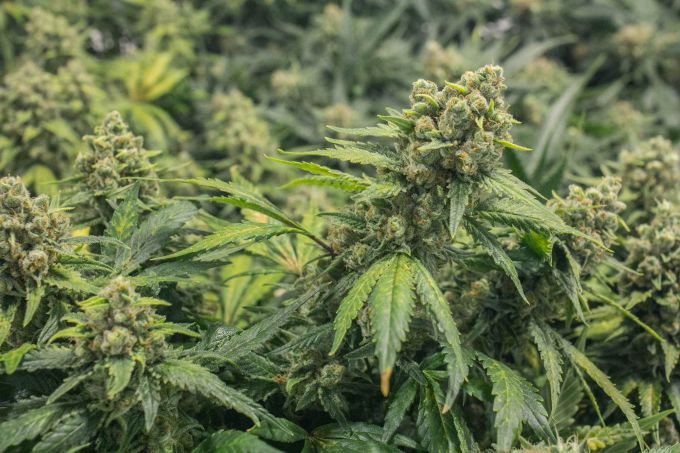
The Entourage Effect Explained
If you’ve been using cannabis for a while, you may have already heard of the entourage effect. If you haven’t—or were a little too high to understand what it is the first time around—we’re here to explain it in depth!
When we ingest cannabis, our bodies don’t just take in THC or CBD, they take in hundreds of compounds that each possess their own effects and benefits. The entourage effect is essentially a theory that cannabis works best when all of its compounds work together in synergy to enhance and influence each other’s effects.
In a study published in the National Library of Medicine in 2020, researchers found that terpenes coupled with cannabinoids could potentially be effective at treating mood and anxiety disorders. This is a prime example of how cannabinoids and other compounds in the plant can work together to enhance each other and achieve better results. In other words, it’s a prime example of how the entourage effect works.
When working together, all of the compounds in cannabis interact with each other to give you, the user, the best possible cannabinoid experience. CBD or THC on their own would likely not be as effective if not for the other compounds, such as terpenes, also found in the miraculous plant.
FAQS
How to tell Indica vs. Sativa
-
The best way to tell whether a product is an indica or sativa is to look at its effects. If its properties include energy, focus, and creativity, it’s sativa. If it promotes rest, relaxation, and pain relief, it’s an indica strain. If it has a little bit of both, it’s likely a hybrid.
How to remember Indica vs. Sativa
-
A good (and fun) way to remember the effects of indica vs. sativa is keeping in mind that indica will leave you “in-di-couch.” If you happen to be a Spanish speaker (or understander), you can remember sativa’s effects with the phrase, “sativa te activa”—AKA, sativa “activates” you.
Does it matter if you’re consuming Indica or Sativa extract when eating edibles?
-
Yes. While edibles take longer and can make cannabis’s effects more pronounced, the strain type the edible is made with will ultimately determine the kind of experience you have. A sativa edible will leave you with a heightened sense of energy, focus, creativity, and euphoria, while an indica edible will have you feeling extra relaxed, mellow, sleepy, and pain-free.
What defines whether a strain is considered to be a “Hybrid?”
-
A hybrid strain refers to a strain made by combining two different strains. Most popularly, it refers to crossing one indica and one sativa and giving users the best of both worlds, but technically, combining two sativa or two indica strains also counts as a hybrid.


